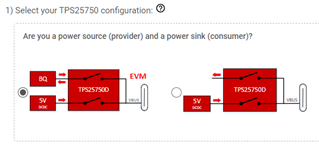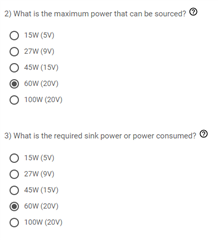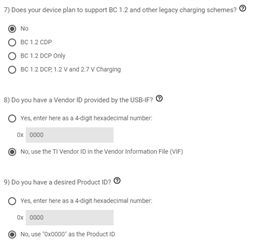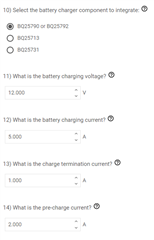Other Parts Discussed in Thread: TPS25750, BQ25798, BQ25792, TPS25751
Tool/software:
Hello, I just purchased the USB-PD-CHG-EVM-01 to charge a 3S battery (using sink capability only) using both "USBCPD Application Customization Tool" and "TPS25750 Application Customization Tool" from the cloud GUI to generate a configuration binary as follow :





The binary file doesn't seem to work, so here are the steps I take:
1) power the EVM using a battery not completely discharged
2) flash the EEPROM using the Aardvark connector J5, CAT24C256 choosen as target on 0x50 adress, write and verify succeed
3) disconnect the battery
4) insert a USB C PD capable charger, the TPS25750 should at this point read the EEPROM configuration and set up itself and the BQ25798 charger
Here the Stat LED blinks but not at the normal 1Hz frequency, on the other hand, the pace is altered, there is no duty cycle of 50% and the period seems to be 3 seconds.
5) when inserting the battery not completely charged, Stat LED stop blinking and PPHV Test point is at 0V, acting like a battery charge complete or battery charge disable.
*TS jumper is applied, 3S jumper is applied
*I have the EVM with a BQ25798 mounted on it and not a BQ25792 as others may have
I don't understand what I'm doing wrong here, and I'm not sure about the binary file and which cloud application I should use to generate it. I have seen in the past people having problems with binary.
This is a rather urgent problem for me, if you can help me out.
Best regards,
NA


